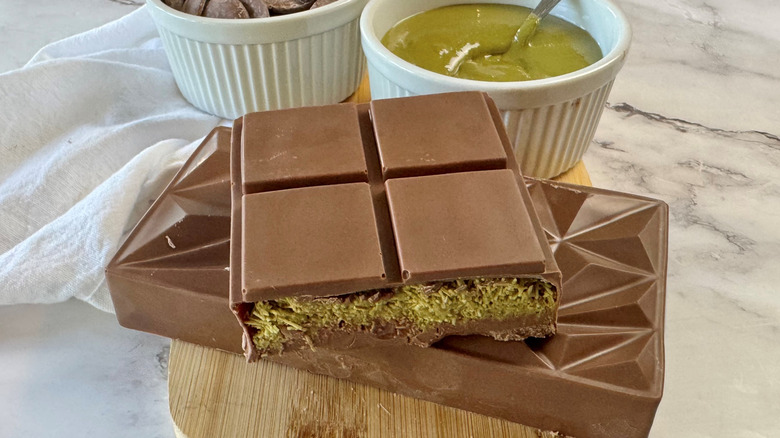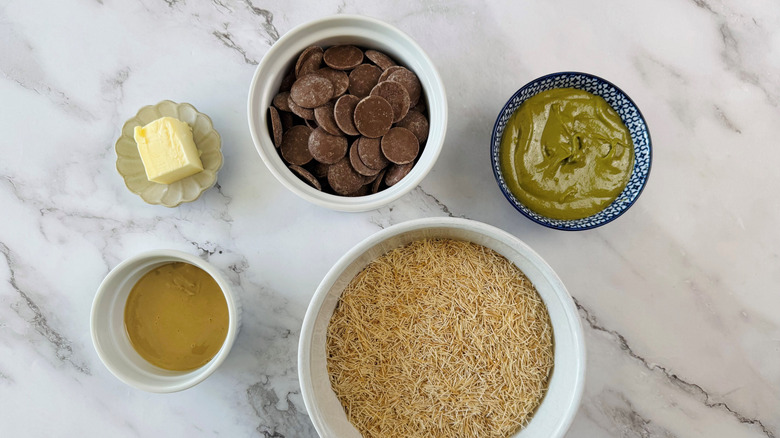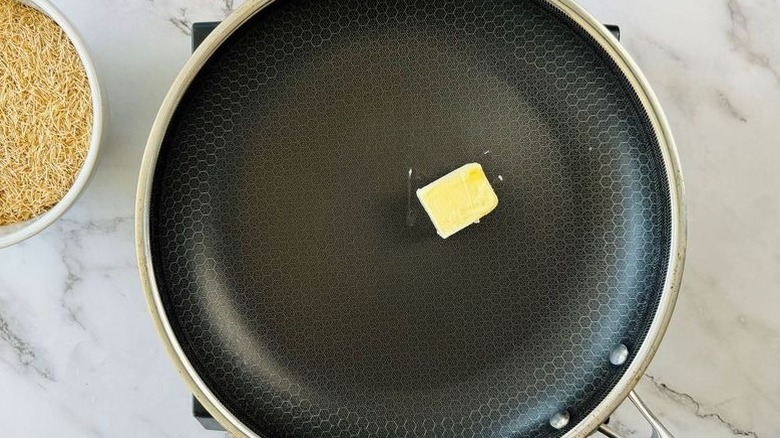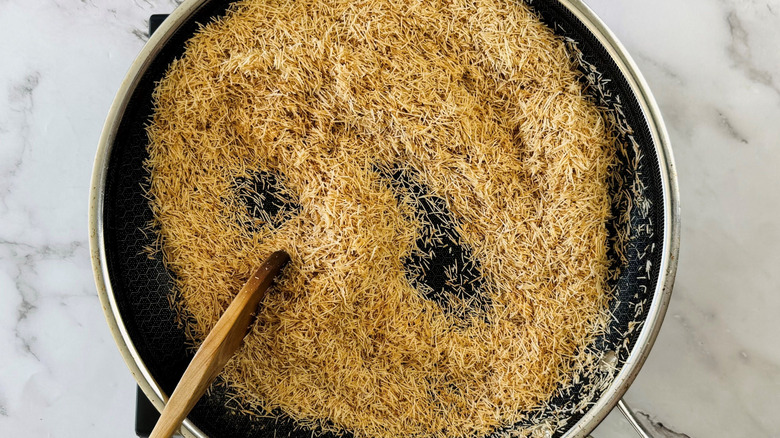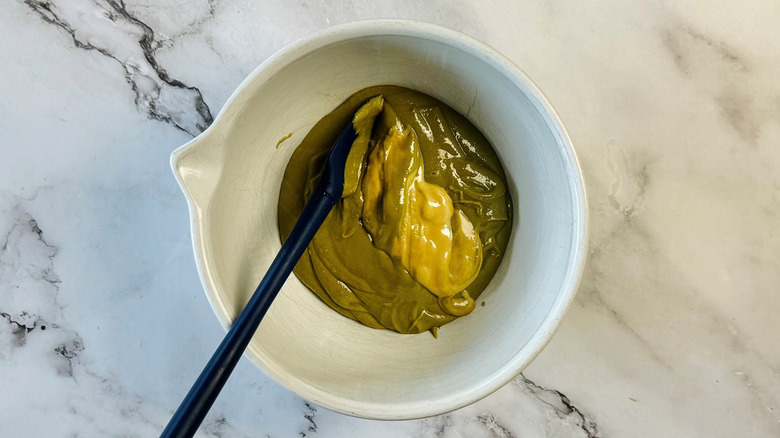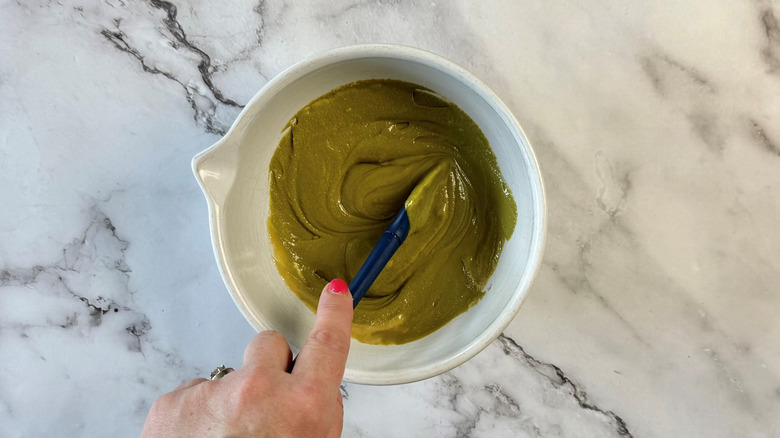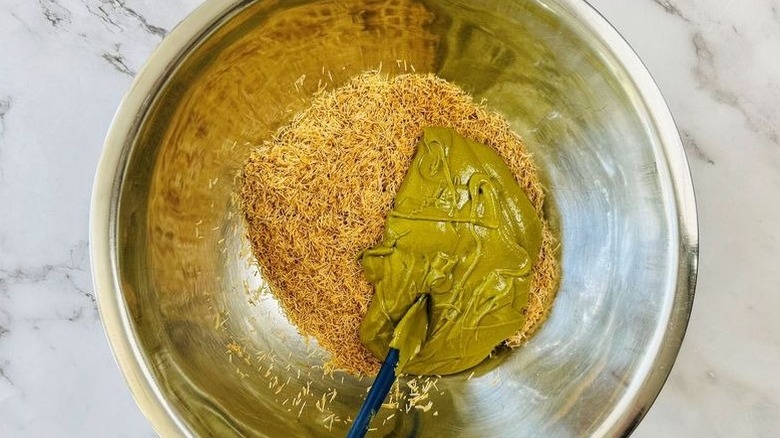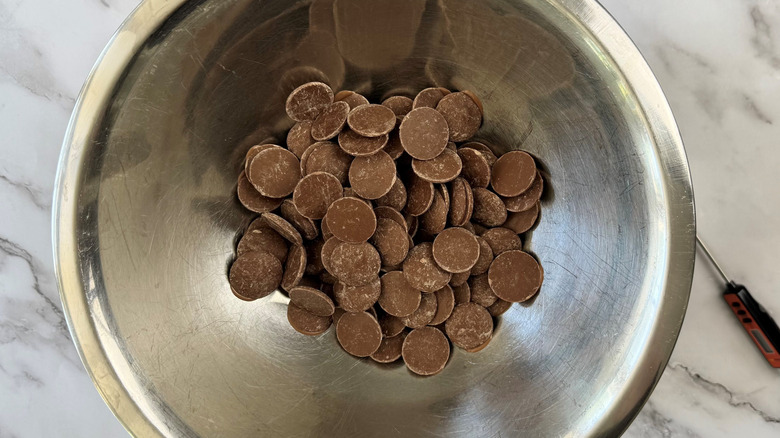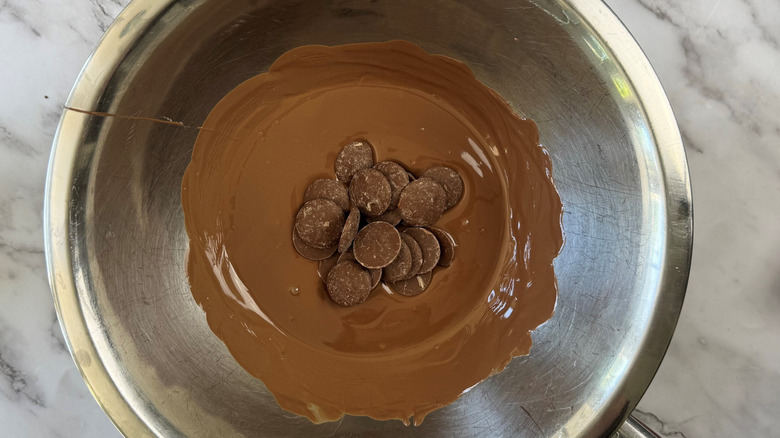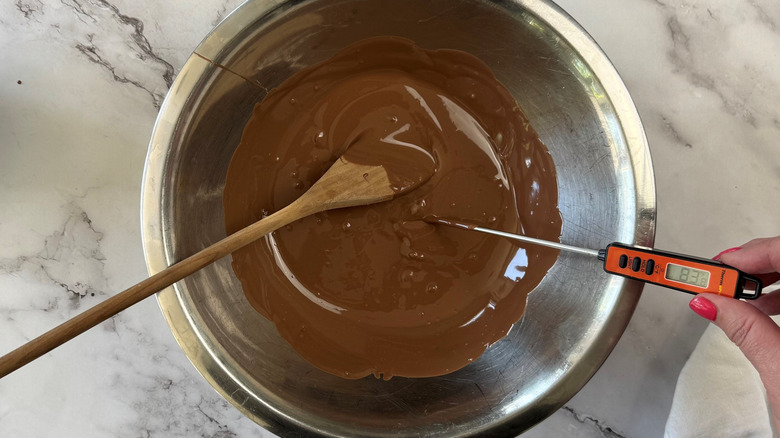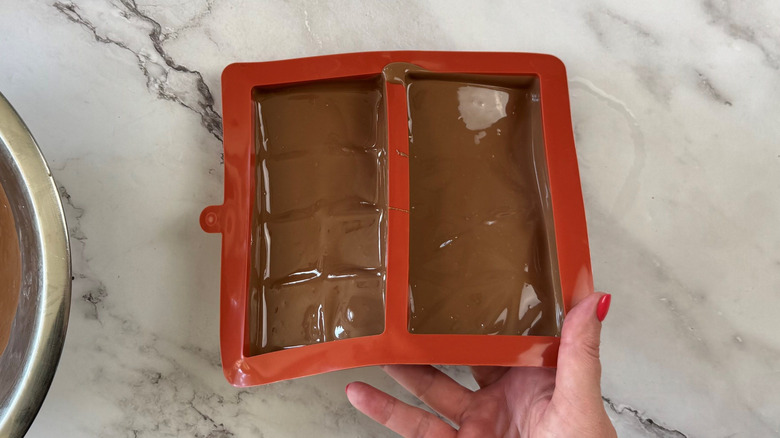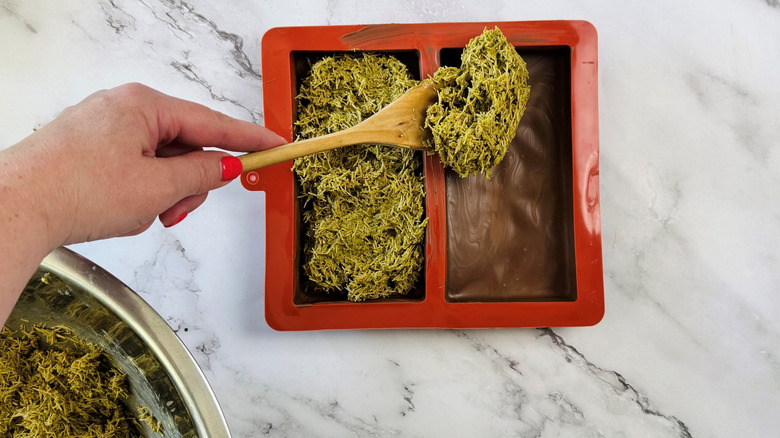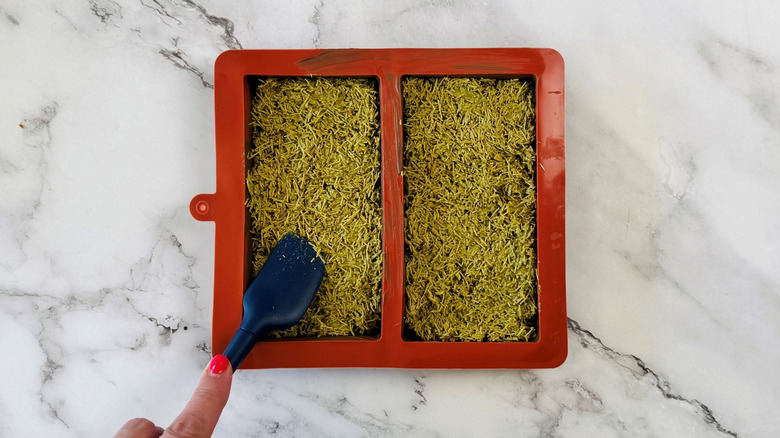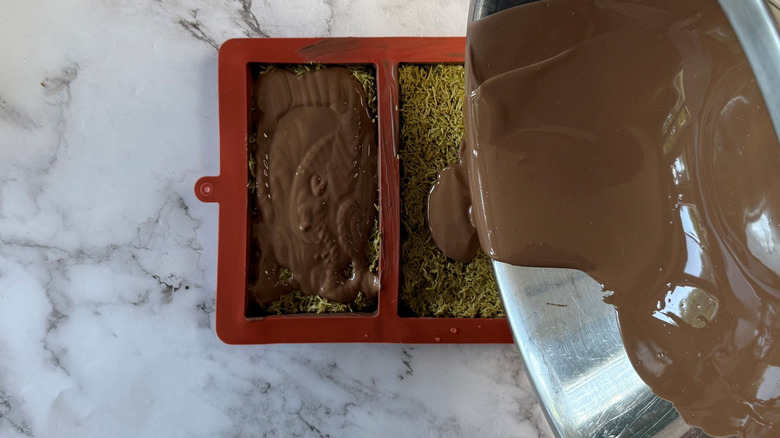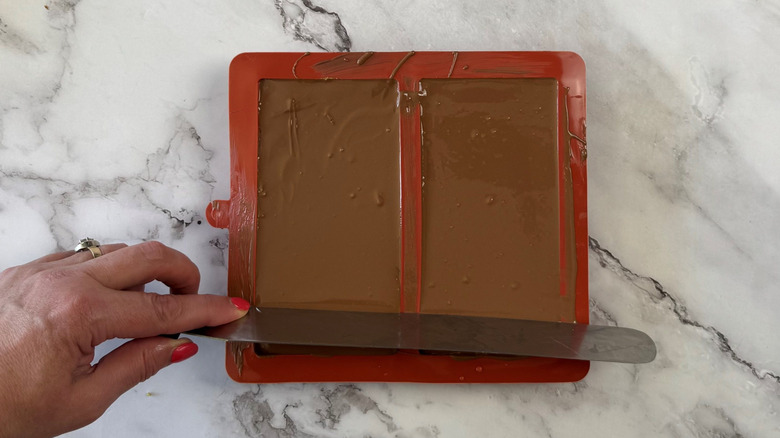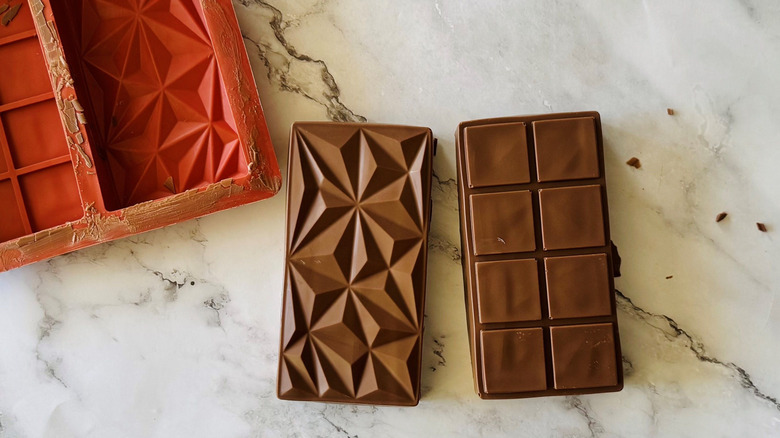Our Homemade Dubai Chocolate Bar Recipe Will Satisfy Your Sweet Tooth
We may receive a commission on purchases made from links.
Food trends come and go all the time, but nothing quite captured (and continues to capture) the dessert scene like Dubai chocolate. The unique milk chocolate bar filled with pistachio cream and kataifi originally debuted in 2022 at Fix Dessert Chocolatier, a sweets shop located in Dubai. Since then, the world of candy bars has not been the same.
You can now find variations of Dubai chocolate bars all around the world — in bakeries, grocery stores, and dessert shops — but these pistachio cream and kataifi-stuffed bars might cost you a pretty penny or two. One solution is to opt for a homemade version of a Dubai chocolate bar, which is exactly what developer Julianne De Witt does with her true-to-the-original recipe. Since Dubai chocolate has become so popular, it's pretty easy to source all of the ingredients you'll need to make a much more cost-effective version at home, from the kataifi down to the candy bar molds.
Gather the ingredients for homemade Dubai chocolate bars
Despite being such a seemingly complex and decadent treat, Dubai chocolate bars require very few ingredients. First, you'll need kataifi (shredded phyllo dough). "You'll want to look for the one that is chopped," De Witt advises, "or you can chop in into smaller pieces for this recipe." Salted butter is also a must to toast the kataifi in. Pistachio cream, tahini, and high-quality milk chocolate are the other ingredients that make up this rich dessert. De Witt uses milk chocolate melting wafers, though you could also use chopped chocolate.
Step 1: Bring out the butter
Melt the butter in a frying pan over medium heat.
Step 2: Toast the kataifi
Add the kataifi and cook it until lightly browned and toasted. Add it to a large mixing bowl.
Step 3: Introduce the pistachio cream and tahini
Add the pistachio cream and tahini to a small bowl.
Step 4: Stir them together
Mix to combine.
Step 5: Combine the two fillings
Add the pistachio cream mix to the kataifi.
Step 6: Give the kataifi and pistachio cream a good mix
Stir together until combined and set aside.
Step 7: Begin to melt the chocolate
Place ⅔ of the chocolate in a medium bowl over a simmering pot of water.
Step 8: Throw in all the chocolate
Stir the chocolate while it melts. When it reaches 113 F, add the remaining chocolate, remove the bowl from the pot of water and stir until the temperature of the chocolate reduces to 82 F.
Step 9: Melt until smooth
Place the bowl back on the pot of simmering water and stir until the temperature reaches 86 F.
Step 10: Mold half of the chocolate
Pour half of the chocolate into two molds. Tip the molds so that the chocolate reaches all the edges and up the sides. Alternatively, you can use a pastry brush to brush the chocolate up the sides of the molds. Tip out the excess chocolate into the bowl.
Step 11: Add the filling after chilling the chocolate
Place the molds in the fridge to chill for 15 minutes, then remove the molds from the fridge and divide the kataifi mixture between the molds making sure to not overfill them.
Step 12: Evenly spread the pistachio-kataifi filling
Spread the mixture into all corners and pat it down, making sure not to over fill the molds.
Step 13: Use up the chocolate
Pour the remaining chocolate over the top.
Step 14: Let it rest in the fridge
Use a spatula to smooth out the chocolate and to remove any excess, then refrigerate for 30 minutes.
Step 15: Demold the Dubai chocolate bars
Remove the chocolate carefully from the molds and serve.
Pairs well with Dubai chocolate bars
Homemade Dubai Chocolate Bar Recipe
The complex taste of Dubai chocolate bars might mislead you to think it's difficult to whip up at home, but it's fairly simple with only five ingredients.
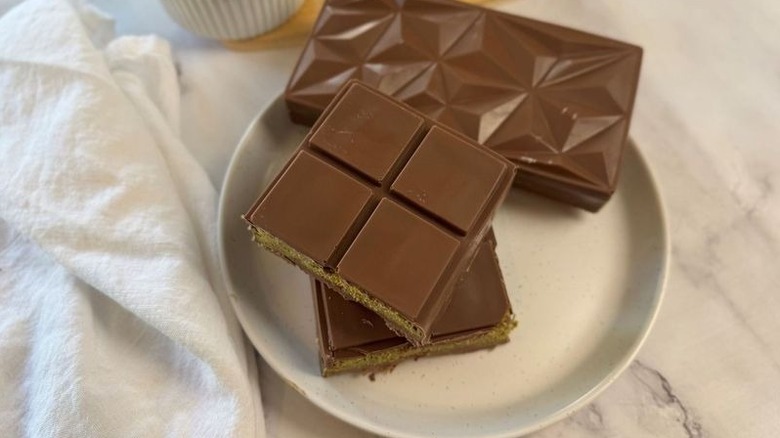
Ingredients
- 3 tablespoons salted butter
- 3 cups kataifi
- ¾ cup pistachio cream
- 2 tablespoons tahini
- 16 ounces good quality milk chocolate
Directions
- Melt the butter in a frying pan over medium heat.
- Add the kataifi and cook it until lightly browned and toasted. Add it to a large mixing bowl.
- Add the pistachio cream and tahini to a small bowl.
- Mix to combine.
- Add the pistachio cream mix to the kataifi.
- Stir together until combined and set aside.
- Place ⅔ of the chocolate in a medium bowl over a simmering pot of water.
- Stir the chocolate while it melts. When it reaches 113 F, add the remaining chocolate, remove the bowl from the pot of water and stir until the temperature of the chocolate reduces to 82 F.
- Place the bowl back on the pot of simmering water and stir until the temperature reaches 86 F.
- Pour half of the chocolate into two molds. Tip the molds so that the chocolate reaches all the edges and up the sides. Alternatively, you can use a pastry brush to brush the chocolate up the sides of the molds. Tip out the excess chocolate into the bowl.
- Place the molds in the fridge to chill for 15 minutes, then remove the molds from the fridge and divide the kataifi mixture between the molds making sure to not overfill them.
- Spread the mixture into all corners and pat it down, making sure not to over fill the molds.
- Pour the remaining chocolate over the top.
- Use a spatula to smooth out the chocolate and to remove any excess, then refrigerate for 30 minutes.
- Remove the chocolate carefully from the molds and serve.
What is kataifi?
Kataifi is an absolute staple ingredient in Dubai chocolate bars, though it's certainly not a new ingredient to the dessert world. De Witt explains that it's a shredded phyllo dough common in Middle Eastern and Greek desserts. "It can be used with other ingredients as a filling or rolled around fillings to make a sweet or savory tart or pastry," she shares. Another common dessert that puts kataifi to good use is Greek ekmek kataifi, a layered treat that features a syrup-soaked kataifi bottom layer, a vanilla custard layer in the middle, and whipped cream with crushed pistachios on top.
In the case of Dubai chocolate, kataifi makes up a large portion of the bar's filling, along with pistachio cream and tahini. Nearly any Dubai chocolate recipe that you come across (including this one) will call for toasting the kataifi, which helps give the shredded dough that ultra-delicate and crispy texture and some extra toasty flavor. You'll have the best luck finding kataifi at Middle Eastern or Turkish grocery stores, though you can also order kataifi online (perhaps when you also buy the chocolate bar molds) and save yourself an extra trip to the store.
What are some tips for making Dubai chocolate bars?
De Witt highlights a few key tips and tricks to ensure that your Dubai chocolate bars will come out perfectly each and every time you make them. For starters, make sure that you're using the highest-quality chocolate you can find (or reasonably afford). "Look for premium milk chocolate in drops or if buying a block of chocolate, cut it into small pieces prior to melting," she advises. Next, though it's not strictly necessary, De Witt highly recommends tempering the chocolate, as she does in this recipe. While you could simply melt the chocolate in the microwave and call it a day, specifically tempering the chocolate gives it an impeccably glossy finish and snappy, crisp texture.
Next, you'll want to make sure that you're completely coating the bottom and sides of your chocolate mold while still pouring out any excess melted chocolate. "This will ensure the filling is completely covered and the chocolate is thick enough to support the filling (but not too thick)," De Witt explains. Make sure to evenly smooth out and pat down the kataifi filling so that there are no gaps in your chocolate bars, and once you pour that final layer of chocolate on top, smooth it out evenly with the mold so that your bars will come out clean and sit flat.
